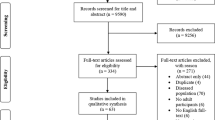Abstract
Purpose
Previous studies have demonstrated that asymmetric scapular posture is often associated with abnormalities of the shoulder complex. However, shoulder asymmetries may be related to adaptations to sports practices and may also be different among healthy athletes from different sports. The purpose of this study was to investigate the effects of activities related to sports on scapular resting position and scapulohumeral rhythm ratio.
Methods
Seventy-five male subjects (15 volleyball players, 15 table tennis players, 15 swimmers, 15 handball players, and 15 non-athletes) participated in this study. All athletes had at least 2 years’ experience in college teams. Two inclinometers were used to measure humeral abduction and scapular up/downward rotation in resting position, 45°, 90°, and 135° humeral abduction in frontal plane. The scapulohumeral rhythm was calculated from scapular resting position to 45º, 90º, and 135º humeral abduction and from 45º to 90º and 90º to 135º humeral abduction.
Results
Findings indicated that there is no asymmetry in up/downward rotation in scapular resting position between dominant and non-dominant shoulders per group (p > 0.05) but handball players’ dominant shoulders had more downward rotation than non-athletes’ dominant shoulders in scapular resting position (p = 0.03). Furthermore, there was a significant difference in scapulohumeral rhythm ratio in different abduction angles among the five groups as table tennis players and non-athletes had more scapulohumeral rhythm ratio than handball players (p < 0.05).
Conclusion
Although there may be no asymmetry in up/downward rotation in scapular resting position in some healthy athletes from different sports and non-athletes, activities related to sports may influence the scapulohumeral rhythm ratio.



Similar content being viewed by others
References
Burkhat SS, Morgan CD, Kibler WB (2003) The disabled throwing shoulder: spectrum of pathology. Part III: the SICK scapula, scapular dyskinesis, the chain, and rehabilitation. Arthroscoov 19:641–661
Ribeiro A, Pascoal AG (2013) Resting scapular posture in healthy overhead throwing athletes. J Manual Therapy 18(6):547–550
Struyf F, Nijs J, Horsten S, Mottram S, Truijen S, Meeusen R (2011) Scapular positioning and motor control in children and adults: a study using clinical measures. J Manual Therapy 16:155–160
Uhl TL, Kibler WB, Gecewich B, Tripp BL (2009) Evaluation of clinical assessment methods for scapular dyskinesis. J Arthroscopy 25(11):1240–1248
Umehara J, Nakamura M, Nishishita S, Tanaka H, Kusano K, Ichihashi N (2018) Scapular kinematic alterations during arm elevation with decrease in pectoralis minor stiffness after stretching in healthy individuals. J Shoulder Elbow Surg 27(7):1214–1220
Kai Y, Gotoh M, Takei K, Madokoro K, Imura T, Murata S, Morihara T et al (2016) Analysis of scapular kinematics during active and passive arm elevation. J Phys Therapy Sci 28(6):1876–1882
Codman EA (1934) Normal motions of the shoulder joint. The shoulder. Thomas Todd Co, Boston, pp 32–64
De Groot JH (1999) The scapulo-humeral rhythm: effects of 2-D roentgen projection. J Clin Biomech 14:63–68
Hosseinimehr SH, Anbarian M, Norasteh AA, Fardmal J, Khosravi MT (2015) The comparison of scapular upward rotation and scapulohumeral rhythm between dominant and non-dominant shoulder in male overhead athletes and nonathletes. J Manual Therapy 20(6):758–762
Inman VT, Saunders JBM, Abbott LC (1994) Observation on the function of the shoulder joint. J Bone Jt Surg 26:1–31
Sahara W, Sugamoto K, Murai M, Tanaka H, Yoshikawa H (2007) The three dimensional motions of glenohumeral joint under semi-loaded condition during arm abduction using vertically open MRI. J Clin Biomech 22:304–312
Yoshizaki K, Hamada J, Tamai K, Sahara R, Fujiwara T, Fujimoto T (2009) Analysis of the scapulohumeral rhythm and electromyography of the shoulder muscles during elevation and lowering: comparison of dominant and non-dominant shoulders. J Shoulder Elbow Surg 18:756–763
Scibek JS, Carcia CR (2012) Assessment of scapulohumeral rhythm for scapular plane shoulder elevation using a modified digital inclinometer. World J Orthoped 3(6):87–94
Laudner KG, Stanek JM, Meister K (2007) Differences in scapular upward rotation between baseball pitchers and position players. Am J Sports Med 35:2091–2095
Thomas SJ, Swanik KA, Swanik C, Huxel KC (2009) Glenohumeral rotation and scapular position adaptations after a single high school female sports season. J Athletic Train 44:230–237
Sale D, MacDougall D (1981) Specificity in strength training: A review for the coach and athlete. Can J Appl Sport Sci 6:87–92
Johnson MP, McClure PW, Karduna AR (2001) New method to assess scapular upward rotation in subjects with shoulder pathology. J Orthop Sports Phys Ther 31:81–89
Author information
Authors and Affiliations
Corresponding author
Ethics declarations
Conflict of interest
The authors have no conflict of interest.
Ethical approval
The study was approved by The Institutional Ethics Committee of Hamedan University of Medical Sciences, Hamadan. Iran.
Informed consent
All subjects provided written informed consent.
Additional information
Publisher's Note
Springer Nature remains neutral with regard to jurisdictional claims in published maps and institutional affiliations.
Rights and permissions
About this article
Cite this article
Hosseinimehr, S.H., Anbarian, M. The effects of activities related to sports on scapular resting position and scapulohumeral rhythm ratio. Sport Sci Health 16, 713–717 (2020). https://doi.org/10.1007/s11332-020-00647-1
Received:
Accepted:
Published:
Issue Date:
DOI: https://doi.org/10.1007/s11332-020-00647-1




